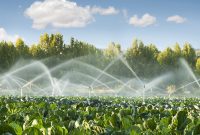The irrigation of agricultural crops accounts for most (80 percent) of the Nation’s water consumption. That is why U.S. agriculture is central to the challenge of balancing increasing water demands for urban, industrial, and environmental uses.
According to the 2012 Census of Agriculture, irrigated farms represented just 14 percent of U.S. farms, but contributed about 39 percent of the country’s farm sales—over $152 billion. The 17 Western States (including Nebraska, California, and Texas) together accounted for nearly three-quarters of all irrigated farms that year. Farm sales for Western irrigated farms averaged $513,272 per farm, over four times the average for Western dryland farms.

To better understand irrigation characteristics, such as acreage and water use, USDA conducts the Farm and Ranch Irrigation Survey (FRIS) every 5 years. The 2013 FRIS, the most recent survey available, reports data for both irrigation on acres in the open (AIO) as well as horticulture under protection (HUP). Crops irrigated on AIO include corn, wheat, and soybeans as well as vegetables, berries, and nut trees. By comparison, crops irrigated on HUP (such as greenhouses) include floriculture crops, nursery crops, and mushrooms.
In 2013, U.S. farms irrigated about 55.4 million acres. This required the application of more than 88.5 million acre-feet (MAF) of water, equivalent to about 28.8 trillion gallons. The irrigation of AIO accounted for nearly all the water use (98 percent).
Most Irrigated Farms Are Low-Sales Operations, But Large Farms Use Most of the Water
The distribution of irrigated farms and acres and applied water varies significantly across farm size. Most irrigated farms in 2013 were low-sales operations with under $150,000 in annual farm sales: 67 percent of Western irrigated farms and 64 percent of U.S. irrigated farms. These farms are plentiful in number because they are very small—averaging less than 50 irrigated crop acres per farm, compared to 1,200 acres for large-scale irrigated farms.
